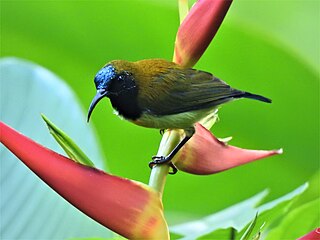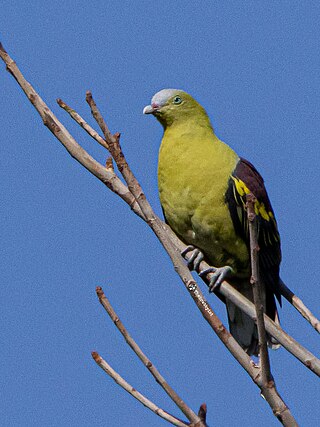
The Philippine tailorbird, also known as the Visayan tailorbird or the Chestnut-crowned tailorbird is a species of bird formerly placed in the "Old World warbler" assemblage, but now placed in the family Cisticolidae. It is native to the Philippines in Western Visayas. Its natural habitats are tropical moist lowland forests, tropical mangrove forests and secondary growth.

The white-eared tailorbird is a species of bird formerly placed in the "Old World warbler" assemblage, it but now placed in the family Cisticolidae.It is found in the Philippine islands of Basilan and West Mindanao.

The gray-backed tailorbird is a species of bird formerly placed in the "Old World warbler" assemblage, it but now placed in the family Cisticolidae. It is endemic to the Philippines found only on the islands of Luzon and Catanduanes.

The rufous-fronted tailorbird is a species of bird formerly placed in the Old World warbler assemblage, but now placed in the family Cisticolidae. It is native to the southern and eastern Philippines. Its natural habitats are tropical moist lowland forests and tropical mangrove forests.

The rufous-headed tailorbird is a species of bird in the family Cettiidae. It is found only in the Philippines on the island of Mindanao. Its natural habitats are in tropical moist montane forest.

The black-headed tailorbird, also known as the white-browed tailorbird, is a species of songbird in the cisticola family, Cisticolidae. First formally described by the Scottish ornithologist Arthur Hay in 1877, it is endemic to the southeastern Philippines, where it is found on the islands of Mindanao, Dinagat, and Siargao. It inhabits dense undergrowth in lowland forests at elevations of up to 1,000 m (3,300 ft).

The yellow-breasted tailorbird is a species of passerine bird formerly placed in the "Old World warbler" assemblage, but now placed in the family Cisticolidae. This species is endemic to Philippines on the islands of Bohol, Samar and Leyte. It is known for its bright color relative to other tailorbirds with a yellow body and a striking black head with a white spot under its chin. Its natural habitat is tropical moist lowland forests. It is threatened by habitat loss.

The lemon-throated leaf warbler is a species of Old World warbler in the family Phylloscopidae. It is endemic to the Philippines found on the islands of Luzon, Negros and Cebu.

The black-faced coucal is a species of cuckoo in the family Cuculidae. It is endemic to the Philippines found in the islands of Mindanao, Basilan Dinagat Islands Bohol, Leyte, Biliran and Samar. It is a striking coucal with its cream head contrasted with a black mask and tail and chestnut wings. Its natural habitat is tropical moist lowland forest.

The rufous coucal is a species of cuckoo in the family Cuculidae. It is found in Luzon and proximate islands in the Philippines. Its natural habitat is tropical moist lowland forest. It is threatened by habitat loss. Along with the Philippine coucal, Black-faced coucal and the critically endangered Black-hooded coucal, it is one of the 4 endemic coucals.

The spotted buttonquail is a species of bird in the family Turnicidae. It is endemic to Philippines on the island of Luzon.

The flaming sunbird is a species of bird in the family Nectariniidae. It is endemic to the northern Philippines found on the islands of Luzon and Catanduanes. Its natural habitat is tropical moist lowland forests. It was formerly conspecific with the Maroon-naped sunbird.

The pygmy flowerpecker is a species of bird in the family Dicaeidae. It is endemic to the Philippines.

The Palawan flycatcher is a species of bird in the family Muscicapidae. It is endemic to the Philippines found only in the region of Palawan. Its natural habitat is tropical moist lowland forests. It is threatened by habitat loss.

The black-and-white triller is a species of bird in the family Campephagidae. It is endemic to the Philippines. Its natural habitat is tropical moist lowland forests.

The green-backed whistler or olive-backed whistler, is a species of bird in the family Pachycephalidae. It is endemic to the Philippines. Its natural habitats are tropical moist lowland forest and tropical moist montane forest.

The whiskered pitta is a rare species of bird in the family Pittidae. It is endemic to Luzon in the Philippines. Along with the Azure-breasted pitta, it is one of two endemic pittas in the country. This bird is the largest pitta in the country reaching 23 cm long and 116 grams in mass. It has a brownish head, blue breast, and red belly. It has broad ash malar or "whiskers". Its natural habitat is tropical moist lowland forest and tropical moist montane forest. It is threatened by habitat loss and trapping. It is one of the most sought after birds by birdwatchers in the Philippines.

The lowland white-eye is a species of bird in the family Zosteropidae. It is near endemic to the northern part of the Philippines but is also found on the Taiwanese islands of Lüdao and Lanyu. Its natural habitat is tropical moist lowland forest, second growth and gardens.

The yellowish white-eye or golden-yellow white-eye, is a species of bird in the family Zosteropidae. It is endemic to the Philippines. Its natural habitat is tropical moist lowland forests.

The Philippine green pigeon is a pigeon in the genus Treron. It is endemic to the Philippines where it lives in the tropical moist lowland forests. It is part of the pompadour green pigeon complex which it was once conspecific with.





















